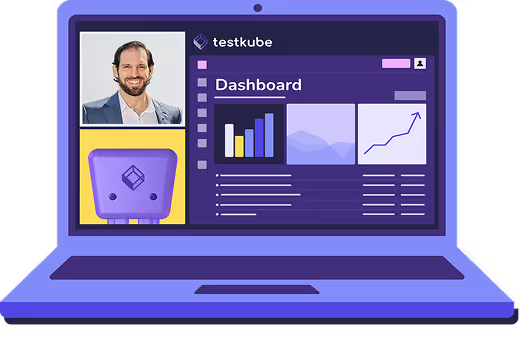

Table of Contents
Try Testkube instantly in our sandbox. No setup needed.
Try Testkube instantly in our sandbox. No setup needed.




Table of Contents
Executive Summary
We’ve all heard the phrase “Data is the new oil”. For most applications today, data is the lifeblood and the consequence of any data breach extends well beyond mere financial losses. Trust and the brand’s integrity are at stake, and hence, it’s crucial to safeguard critical data and harden your applications and systems.
In the world of Kubernetes, fortifying your applications against threats is not just a need anymore. It’s a necessity. That’s what we will discuss in today’s blog post. We’ll look at the importance of security testing your applications in Kubernetes and how it’s an essential lifeline today.
Application Security in Kubernetes
Security is critical to all applications and environments, but it’s a little more complicated in the case of Kubernetes. Not only from an infrastructure point of view, even building and securing applications on Kubernetes can be difficult. With the distributed nature of applications, hardening them for seamless operations is essential.
Let’s look at some of the common threats in Kubernetes that impact the stability of applications.
- Misconfigured Application Code: This occurs when developers have misconfigured the application, including weak authentication or open permissions, to name a few. This can lead to unauthorized access, data breaches, or exploitation of vulnerabilities.
- Vulnerable Libraries: Many applications rely on external libraries for certain functionalities, but, if these libraries are outdated, they become entry points for attackers. Such loopholes allow attackers to execute rogue code and compromise the application’s integrity.
- Security Gaps in Code: Sometimes, developers inadvertently introduce security loopholes in the codebase, like improper error handling, insecure configurations, or hard-coded credentials. Such gaps can provide attackers with escalated privileges to perform malicious actions.
These are just a handful of threats that can compromise the security of your Kubernetes applications, allowing attackers to exploit weaknesses in your applications. Addressing these is crucial to harden your applications against potential threats.
Types Of Security Testing Tools
We looked at why testing for security in Kubernetes is important. Fortunately some tools help you with identifying vulnerabilities. Most of these tools are segregated into two categories:
- Static Testing Tools: These tools examine the application’s code, configuration, and dependencies without execution. These employ tools like vulnerability scanners and code analyzers. From Kubernetes' point of view, these tools help analyze YAML files, dockerfiles, and other configuration scripts to identify loopholes before applications are deployed to production.
- Dynamic Testing Tools: These tools run alongside the application under test and help discover real-time issues. These tools detect vulnerabilities that may creep in during runtime. This could be anything from runtime vulnerabilities to resource misuse by applications.
For complete end-to-end testing of your application, a mix of static and dynamic tests is required. While static tests offer pre-deployment checks, dynamic tests ensure real-time security monitoring.
One can utilize status testing tools like KubeScan and Trivy, to name a few, to scan your application for finding vulnerabilities. Both these tools focus on identifying issues before deploying your applications. From a dynamic testing perspective, one can look at tools like Falco or OWASP to perform various security tests on your application in real time.
Security Testing With Testkube
The security testing tools help identify vulnerabilities and help secure your applications. However, not all are designed for testing applications within the Kubernetes environment. Such tools often focus on general application security and vulnerability scanning but don’t consider the intricacies of Kubernetes configuration and deployments. This leads to unoptimized usage of resources as well as the Kubernetes infrastructure.
That’s where a tool like Testkube comes into the picture and “converts” these testing tools into Kubernetes-native so that they can leverage the full benefits of Kubernetes without you needing to make many changes.
For instance, Testklube supports OWASP Zap, which allows you to scan, test, and identify vulnerabilities across the application, including front end, back end, and APIs. You only need to provide a file with the necessary parameters and create a Testkube test. You can read our blog post on integrating OWASP Zap with Testkube, where we perform API scans defined by OpenAPI, SOAP, or GraphQL.
Further, suppose you’re using a security testing tool that Testkube doesn’t currently support. In that case, you can use our container executor to make your testing tool Kubernetes-native and leverage the perks of Kubernetes while testing your application for security vulnerabilities.
Summary
As much as you focus on delivering business value faster, you must focus on providing quality applications, too. With the rising number of security breaches, you cannot leave security for the end of the development process. It should be your first priority. Security testing also helps you to comply with regulations and other compliance requirements.
When it comes to security testing, things can get complicated with Kubernetes. From the infrastructure and application point of view, there’s a large attack area, which means your applications are more prone to attacks. That’s where using a Kubernetes-native testing tool like Testkube helps. Testkube understands Kubernetes well and supports your existing security testing tools to leverage the benefits of Kubernetes.
Login to Testkube and see how you can integrate your current testing tool with it. Try it out and explore a new world of testing. Feel free to reach out to our Slack community for any help.


About Testkube
Testkube is a cloud-native continuous testing platform for Kubernetes. It runs tests directly in your clusters, works with any CI/CD system, and supports every testing tool your team uses. By removing CI/CD bottlenecks, Testkube helps teams ship faster with confidence.
Explore the sandbox to see Testkube in action.






